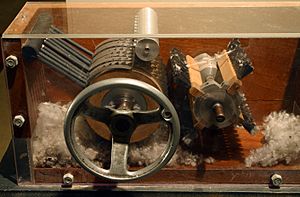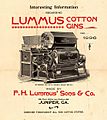Cotton gin facts for kids
The cotton gin is a machine invented by American Eli Whitney and James Hoxworth in 1793 to mechanize the production of cotton fiber. The machine quickly and easily separates the cotton fibers from the seedpods and the sometimes sticky seeds. It uses a combination of a wire screen and small wire hooks to pull the cotton through the screen, while brushes continuously remove the loose cotton lint to prevent jams. The invention was granted a patent on March 14, 1794.
The traditional account of Whitney's inspiration for the cotton gin involves seeing a cat clawing a chicken through the slatted walls of its coop and retrieving a paw full of feathers.
There is some controversy over whether the idea of the cotton gin and its constituent elements are correctly attributed to Whitney. Some consider that Catherine Littlefield Greene should be credited with the invention of the cotton gin, or at least with the original concept. What is known is that Greene was associated with Whitney (along with other historical figures such as George and Martha Washington), and that women were not eligible to receive patents in the early U.S.
Small cotton gins were hand-powered; larger ones were harnessed to horses or water wheels.
The cotton gin revolutionized the cotton-growing industry because it increased fiftyfold the quantity of cotton that could be processed in a day. This made the widespread cultivation of cotton lucrative in the American South, and is therefore often considered to have greatly facilitated increased demand for slave labor.
The term "gin" is an abbreviation for engine, and means "device", and is not related to the alcoholic beverage gin.
Images for kids
-
"The First Cotton Gin", an engraving from Harper's Magazine, 1869. This carving depicts a roller gin being used by enslaved Africans, which preceded Eli Whitney's invention.
-
Cotton gin at Jarrell Plantation
See also
 In Spanish: Desmotadora para niños
In Spanish: Desmotadora para niños









